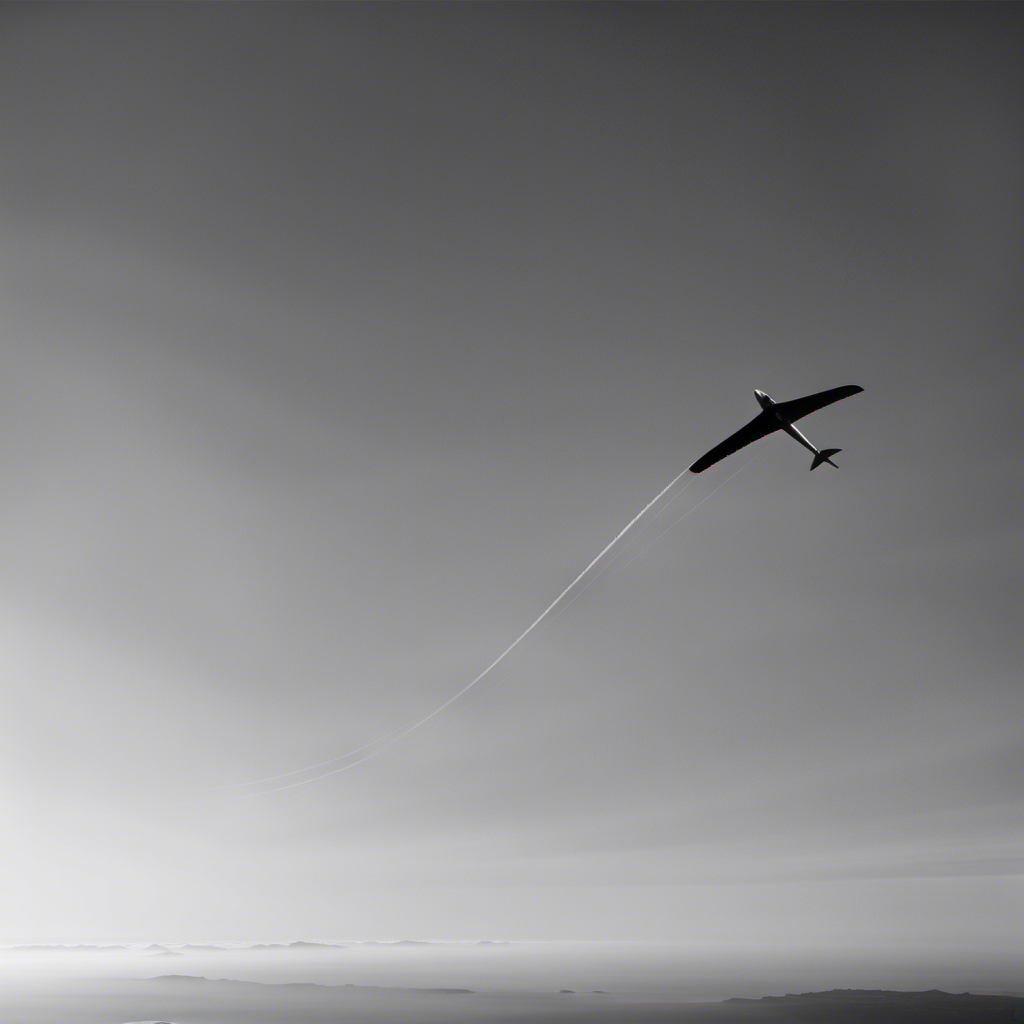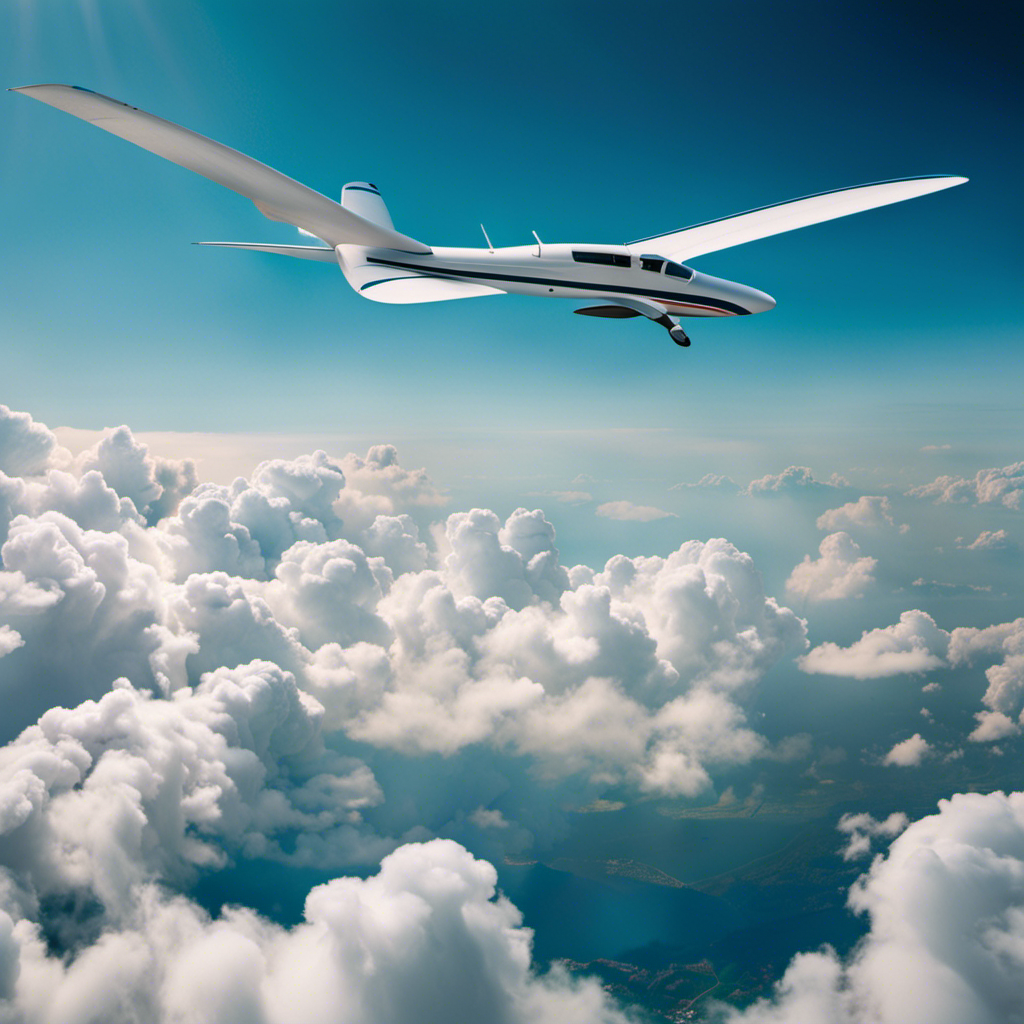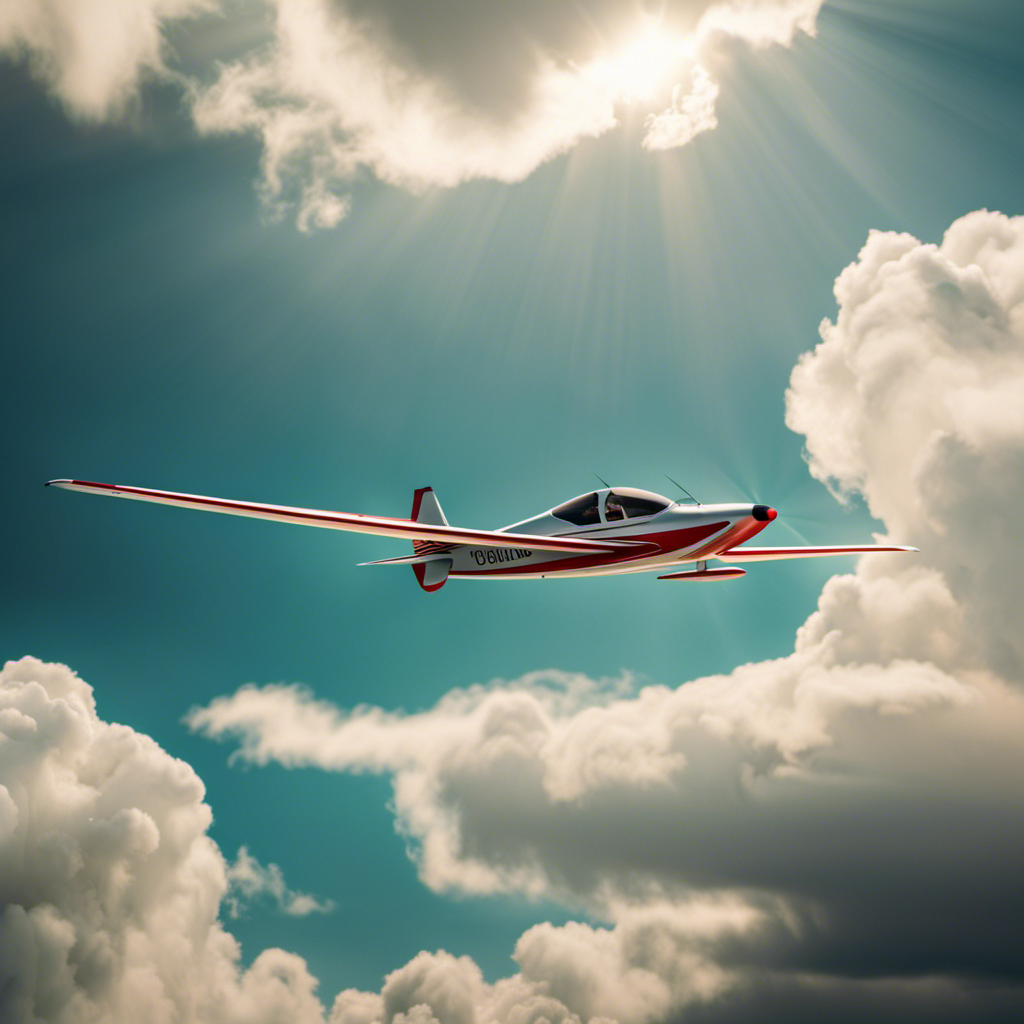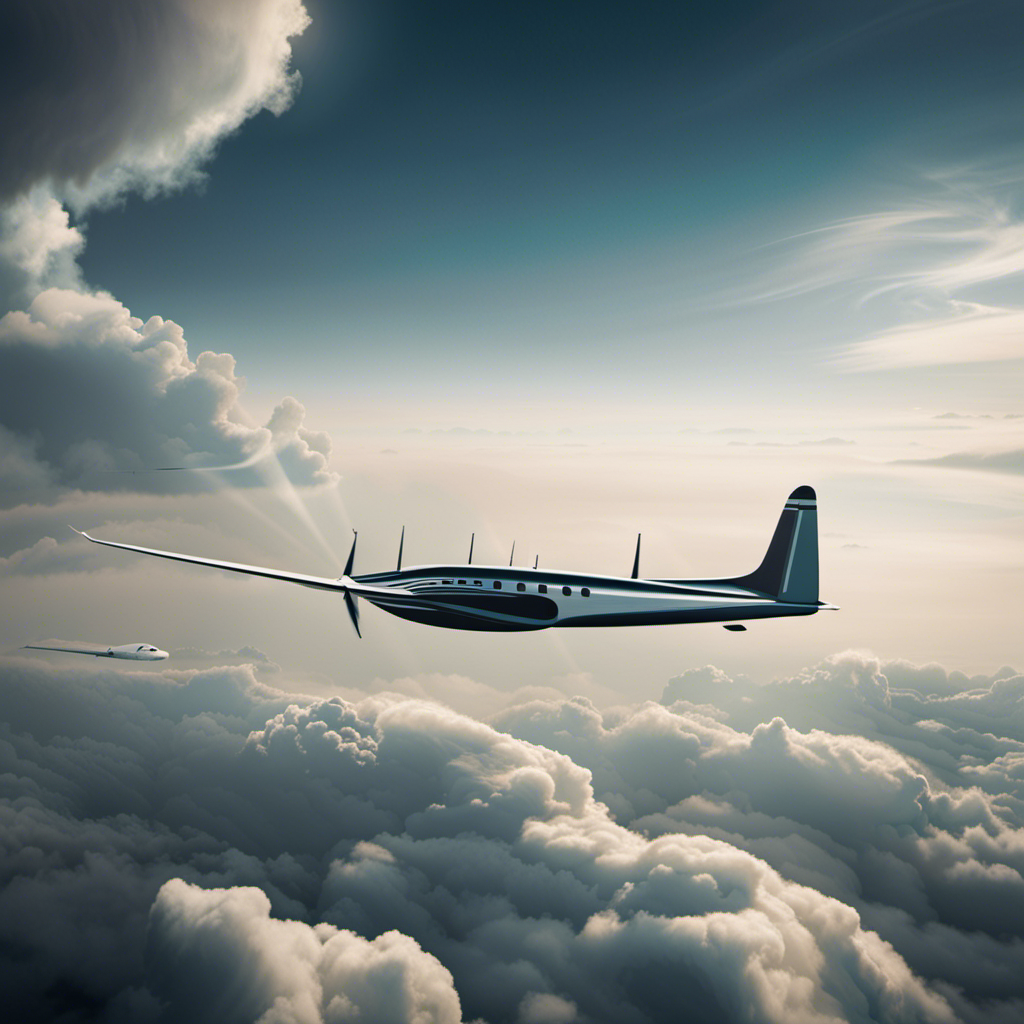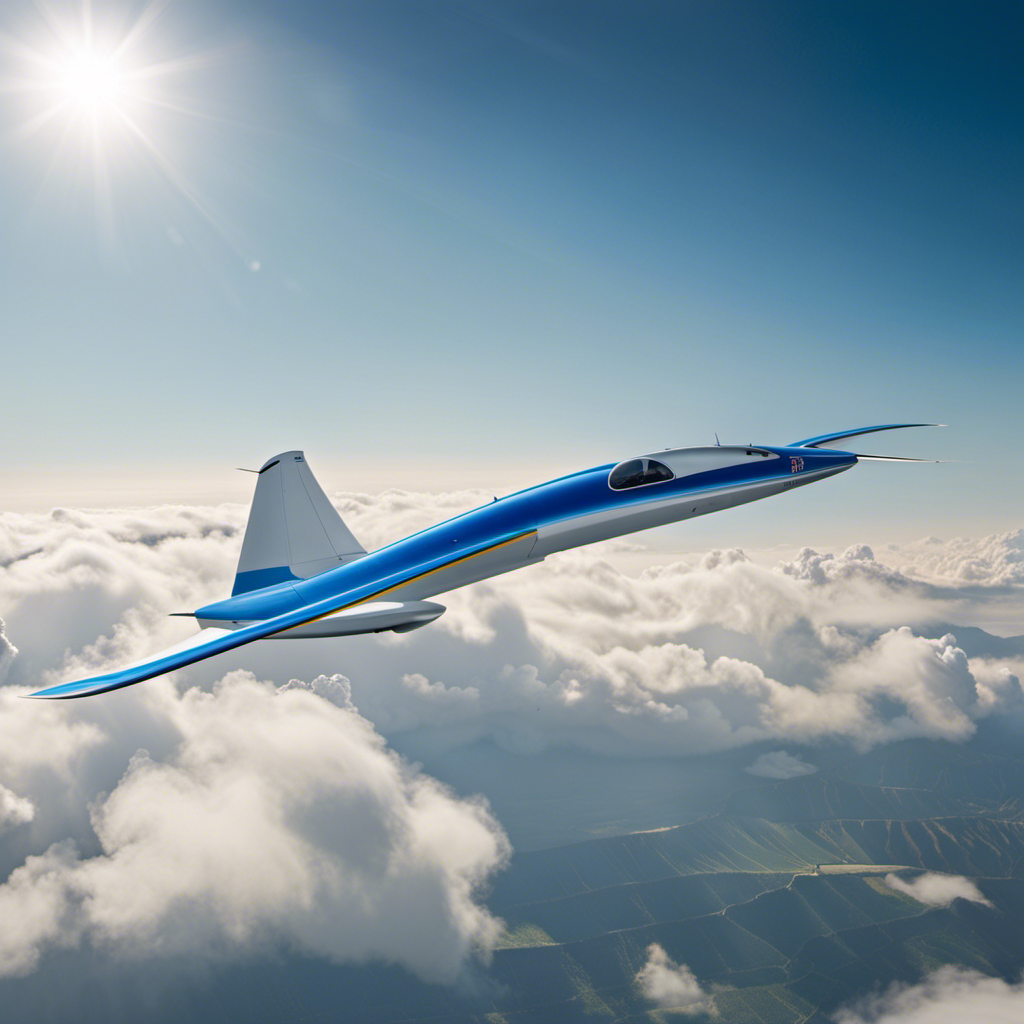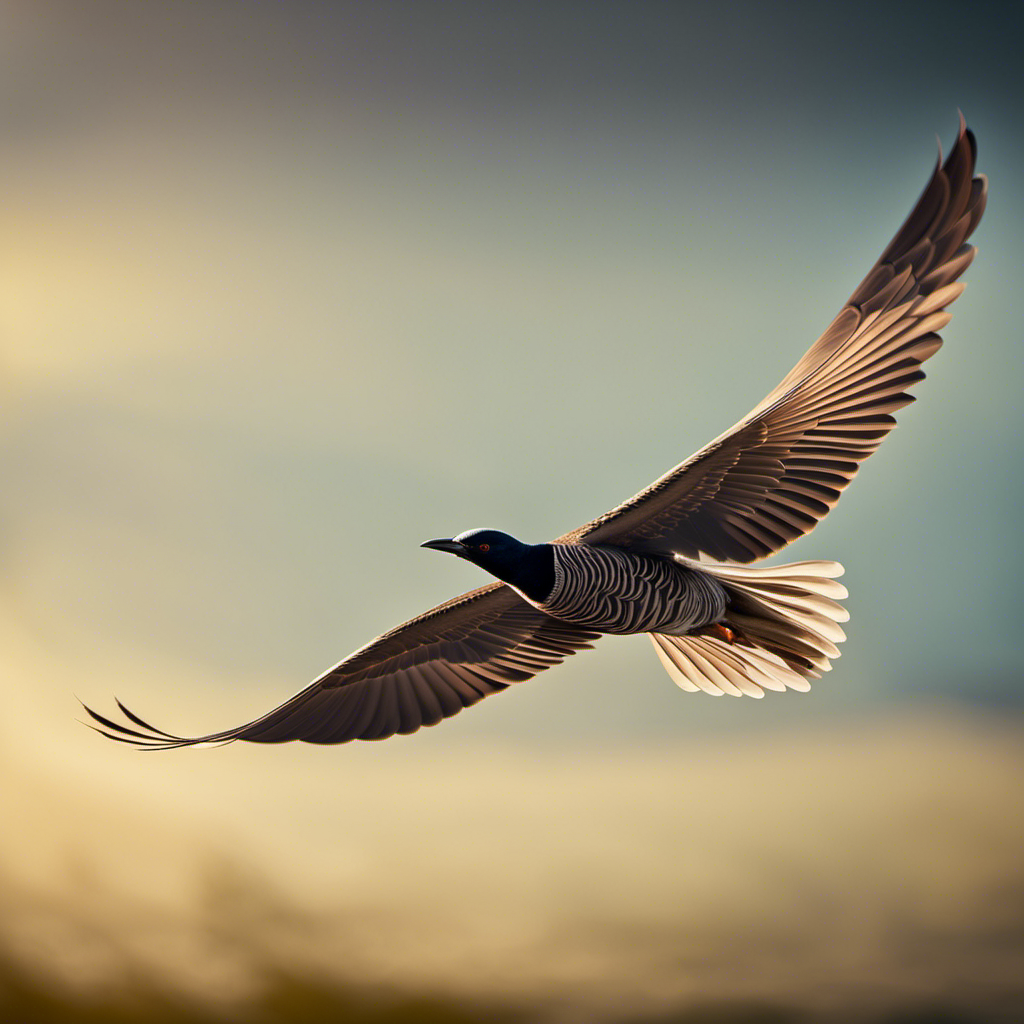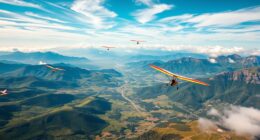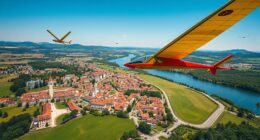Similar to the graceful glide of a bird through the clear blue sky, glider planes possess a sleek and elegant beauty that captivates aviation enthusiasts worldwide.
In this comprehensive breakdown, I will delve into the principles of glider flight, explore the different types of gliders, and analyze the intricate anatomy of these magnificent machines.
We will also uncover the various launching methods and soaring techniques used by glider pilots, as well as the safety procedures and emergency protocols essential to this exhilarating sport.
Join me on this journey as we unravel the mysteries and possibilities of glider aircraft.
Key Takeaways
- Lift is generated by the shape of the wings and air movement, and adjusting the angle of attack controls lift.
- Gliders come in different types, including sailplanes, motor gliders, and ultralight gliders, each with their own characteristics and uses.
- The anatomy of a glider includes wings, winglets, fuselage, cockpit, tail surfaces, and control surfaces, all of which play a role in flight and maneuverability.
- Launching methods for gliders include winch launching, hand launching, and aerotow, and soaring techniques such as thermals, ridge lift, dynamic soaring, and wave lift optimize flight time and altitude.
Principles of Glider Flight
The principles of glider flight can be understood by studying the concepts of lift and drag. Lift is the force that allows a glider to stay airborne and is generated by the shape of the wings and the movement of air over them. The glider’s wings are designed to create a pressure difference between the upper and lower surfaces, resulting in an upward force. This force counteracts the pull of gravity, allowing the glider to stay aloft.
Drag, on the other hand, is the resistance encountered by the glider as it moves through the air. It is caused by factors such as air friction and the shape of the glider’s fuselage. Minimizing drag is crucial for maximizing glider performance and achieving longer flight times.
Understanding the principles of glider flight dynamics is essential for pilots to control and maneuver the aircraft effectively. By adjusting the angle of attack, which is the angle between the wing’s chord line and the oncoming airflow, pilots can increase or decrease the lift generated by the wings. This allows them to control the glider’s ascent and descent. Additionally, by manipulating the control surfaces, such as the ailerons and elevator, pilots can change the glider’s direction and stabilize its flight.
Transitioning into the subsequent section about ‘types of gliders,’ it is important to note that different glider designs and configurations can impact the principles of glider flight and performance.
Types of Gliders
There are several different types of gliders that pilots can choose from. When it comes to glider design, there are three main categories: sailplanes, motor gliders, and ultralight gliders.
Sailplanes are the most common type and are solely dependent on natural forces to stay aloft, such as thermal updrafts and ridge lift. Motor gliders, on the other hand, are equipped with an engine that can be used for takeoff and climbing, but can also be shut off to soar like a sailplane. Lastly, ultralight gliders are lightweight and often have a simpler design, allowing for easy launching and maneuverability.
When considering glider performance, factors such as glide ratio, sink rate, and maximum speed come into play. Glide ratio is a measure of how far the glider can travel horizontally for every unit of altitude lost. A higher glide ratio indicates better performance. Sink rate, on the other hand, measures how quickly the glider descends when not in lift. A lower sink rate is desirable as it allows the pilot to stay aloft longer. Maximum speed refers to the highest speed the glider can attain during flight.
Understanding the different types of gliders and their performance characteristics is crucial for pilots in choosing the right aircraft for their needs. Now, let’s delve into the anatomy of a glider to gain a deeper understanding of its structure and components.
Anatomy of a Glider
When it comes to understanding the anatomy of a glider, there are three key areas to focus on: the wings and winglets, the fuselage and cockpit, and the tail surfaces and control surfaces.
The wings and winglets are crucial components that provide lift and stability during flight.
The fuselage and cockpit house the pilot and any passengers, as well as the controls and instruments necessary for operating the glider.
The tail surfaces, including the horizontal stabilizer and vertical fin, along with the control surfaces like the elevator and rudder, play a critical role in maneuvering the glider in the air.
Wings and Winglets
Winglets help improve the aerodynamic performance of glider aircraft. They are small, upward-pointing extensions at the tip of the wing. Here are four key points about winglets and their impact on glider design and aerodynamic efficiency:
-
Reduced drag: Winglets reduce the formation of wingtip vortices, which are swirling air currents that create drag. By minimizing these vortices, winglets decrease drag and increase overall efficiency.
-
Improved lift-to-drag ratio: Winglets enhance the lift-to-drag ratio by reducing induced drag. This allows gliders to maintain lift with less drag, resulting in longer flight times and increased range.
-
Increased stability: Winglets provide better lateral stability by reducing the tendency for the glider to roll in flight. This improves handling and control, especially during turbulent conditions.
-
Enhanced fuel efficiency: With reduced drag and improved lift-to-drag ratio, winglets help gliders to fly more efficiently and conserve energy. This translates to longer flights and reduced fuel consumption.
Transitioning to the next section, the fuselage and cockpit play crucial roles in the overall design and functionality of a glider.
Fuselage and Cockpit
The fuselage and cockpit are key components in the design and functionality of a glider. The fuselage acts as the main structure of the glider, providing support and housing various systems and components. Its design plays a crucial role in the overall aerodynamics and performance of the glider. The cockpit, on the other hand, is where the pilot sits and operates the aircraft. Cockpit ergonomics are essential to ensure the pilot’s comfort and ease of operation. Here is a table showcasing some key aspects of fuselage design and cockpit ergonomics:
| Fuselage Design | Cockpit Ergonomics |
|---|---|
| Streamlined shape | Comfortable seating |
| Lightweight materials | Easy access to controls |
| Strong and rigid structure | Clear visibility |
| Aerodynamic fairings | Instrumentation placement |
| Efficient canopy design | Ergonomic control layout |
Now, let’s move on to the next section, where we will explore the tail surfaces and control surfaces of a glider.
Tail Surfaces and Control Surfaces
Tail surfaces and control surfaces are crucial for the stability and maneuverability of a glider. These surfaces play a vital role in controlling the glider’s movement during flight.
-
Elevator Control:
The elevator, located on the horizontal tail surface, controls the glider’s pitch or nose-up and nose-down attitude. By deflecting the elevator up or down, the pilot can adjust the glider’s angle of attack, allowing for changes in altitude. This control surface is operated by the pilot through a control stick or wheel in the cockpit. -
Aileron Control:
Ailerons are located on the outer trailing edges of the wings and control the roll of the glider. By moving one aileron up and the other down, the glider can bank into a turn. The pilot operates the ailerons using the control stick or wheel, allowing for precise control during flight.
These control surfaces are essential for maneuvering the glider through the air, ensuring a smooth and controlled flight. Understanding how to manipulate the elevator and ailerons effectively is crucial for a glider pilot.
Transitioning into the subsequent section about ‘launching methods,’ we can now explore how gliders are launched into the air without the use of an engine.
Launching Methods
There’s no denying that launching a glider using a winch is a popular method among glider pilots. However, there are other methods of launching a glider that are worth exploring. Two common methods are hand launching and aerotow. Hand launching involves physically launching the glider into the air by hand, typically with the assistance of a helper. This method requires skill and coordination to ensure a successful launch. On the other hand, aerotow involves using a powered aircraft to tow the glider into the air. This method allows for a controlled and efficient launch, as the powered aircraft provides the necessary lift and speed for the glider to take off smoothly.
To better understand the differences between these launching methods, let’s compare them in a table:
| Launching Method | Pros | Cons |
|---|---|---|
| Hand Launching | – No need for additional equipment | – Requires physical strength and coordination |
| Aerotow | – Controlled and efficient launch | – Requires a powered aircraft and trained pilot |
Understanding the various launching methods is crucial for glider pilots, as it allows them to choose the most suitable method based on the conditions and their own capabilities.
Transitioning into the next section about soaring techniques, it is important to note that once a glider is launched, pilots employ various techniques to stay aloft and maximize their flight time.
Soaring Techniques
Once a glider is launched, pilots use different techniques to stay in the air and maximize their flight time. As an experienced glider pilot, I have honed my skills in using these techniques to soar through the skies with precision and finesse. Here are the soaring techniques that I employ:
-
Thermals: These are upward currents of warm air that can be found by sensing changes in temperature and humidity. Riding thermals allows me to gain altitude and extend my flight.
-
Ridge lift: When wind meets a hill or mountain, it creates an updraft along the slope. By flying close to the ridge, I can utilize this lift to stay airborne for longer periods.
-
Dynamic soaring: This technique involves flying in a circular pattern, taking advantage of the different wind speeds at various altitudes. It allows me to maintain my energy and continue flying for extended durations.
-
Wave lift: When wind encounters a mountain range, it can create standing waves in the air. By flying in these waves, I can harness the upward lift and soar to higher altitudes.
These soaring techniques not only provide an exhilarating experience but also require a deep understanding of atmospheric conditions and precise control of the glider.
Transitioning into the next section about navigation and control, I will discuss how these techniques are intertwined with the pilot’s ability to navigate and control the glider in the most efficient manner possible.
Navigation and Control
Using precise navigation techniques and maintaining control of the glider are essential for a successful flight. Glider aerodynamics play a crucial role in understanding how the aircraft responds to different inputs and maneuvers. The glider instrument panel is equipped with various instruments that provide vital information to the pilot, enabling them to navigate and control the aircraft effectively.
One of the key aspects of glider aerodynamics is understanding the concept of lift. Lift is generated by the interaction between the wings and the air flowing over them. By adjusting the angle of attack, pilots can control the amount of lift being generated, allowing them to ascend or descend as desired. Additionally, ailerons and rudder controls are used to maintain stability and make coordinated turns.
The glider instrument panel provides pilots with important information, such as airspeed, altitude, and vertical speed. This data helps pilots make accurate decisions regarding navigation and control. For example, knowing the airspeed allows pilots to determine the optimal speed for maximum efficiency during different phases of flight, while altitude information is crucial for maintaining safe separation from other aircraft and terrain.
In conclusion, understanding glider aerodynamics and utilizing the information provided by the instrument panel are essential for successful navigation and control. These techniques and tools empower pilots to make precise adjustments and ensure a smooth flight.
Transitioning into the next section, safety and emergency procedures are equally important in ensuring the well-being of the pilot and passengers.
Safety and Emergency Procedures
Safety and emergency procedures are crucial for ensuring the well-being of the pilot and passengers during a glider flight. As a pilot, I understand the importance of being prepared for any unforeseen circumstances that may arise. Here are a few key elements that play a vital role in the safety of a glider flight:
-
Safety equipment: Before takeoff, it is essential to ensure that all safety equipment is in proper working condition. This includes items such as parachutes, harnesses, and helmets. These pieces of equipment can potentially save lives in the event of an emergency.
-
Emergency landing: Gliders are designed to glide effortlessly through the air, but sometimes unforeseen circumstances might force an emergency landing. In such situations, pilots must be trained to identify suitable landing areas and execute a smooth landing to minimize the risk of injury to themselves and passengers.
-
Emergency procedures: Pilots are trained in emergency procedures such as dealing with a loss of control, managing fires, and handling equipment failures. These procedures are practiced regularly to ensure quick and efficient responses during critical situations.
-
Communication protocols: Clear communication is essential during emergencies. Pilots must establish effective communication with air traffic control and other pilots to coordinate emergency responses and ensure the safety of everyone involved.
Understanding these safety and emergency procedures is crucial for every pilot. By following these protocols, we can ensure the well-being of everyone on board and mitigate any potential risks.
Transitioning into the subsequent section about ‘gliding competitions and records,’ it is important to note that safety remains a top priority even in the world of gliding achievements and accomplishments.
Gliding Competitions and Records
Competitors in gliding competitions strive to achieve new records and push the limits of the sport. To achieve these feats, glider technology has undergone significant advancements in recent years. The development of lighter and more aerodynamically efficient gliders has allowed pilots to achieve longer flight times and higher speeds. These technological advancements have not only revolutionized the sport but have also contributed to the success of gliding championships around the world.
In gliding championships, pilots compete against each other to showcase their skills and reach new heights. The competitions often involve various tasks, such as racing against the clock or flying specific courses. Pilots rely on their knowledge of glider technology to make informed decisions during these competitions. They analyze weather conditions, study air currents, and strategize to maximize their glider’s performance.
Moreover, gliding championships serve as a platform for testing and showcasing the latest innovations in glider technology. Manufacturers invest in research and development to create gliders that are faster, more maneuverable, and more efficient. These advancements not only benefit the competitors but also contribute to the overall progress of the sport.
Transitioning to the subsequent section about training and certification, understanding these technological advancements is crucial for pilots aiming to compete in gliding championships. However, achieving success in gliding competitions requires more than just knowledge of glider technology.
Training and Certification
Moving on from the exhilarating world of gliding competitions and records, let’s delve into the crucial aspects of training and certification. In order to safely navigate the skies in a glider aircraft, pilots must undergo rigorous training to develop the necessary skills and knowledge.
Various training methods are employed to ensure that aspiring glider pilots are equipped with the skills to handle different flying situations. These methods include ground school instruction, flight simulation, and hands-on flying experience. Ground school instruction covers topics such as aerodynamics, meteorology, navigation, and emergency procedures. Flight simulation allows pilots to practice maneuvers and procedures in a controlled environment, while hands-on flying experience provides the opportunity to apply theoretical knowledge in real-world situations.
Pilot qualifications are essential to ensure the safety of both the pilot and the aircraft. In most countries, pilots must obtain a glider pilot license, which involves passing written exams, demonstrating flying skills, and meeting specific flight hour requirements. Additionally, pilots may need to undergo recurrent training and proficiency checks to maintain their certification.
As we examine the training and certification process, it becomes clear that glider pilots undergo extensive preparation to ensure their competence in the skies. This emphasis on training and qualifications contributes to the overall safety and professionalism of the gliding community.
Looking ahead, let’s explore the future of glider aircraft and the innovations that lie on the horizon.
The Future of Glider Aircraft
While exploring the future of glider aircraft, you’ll be amazed by the potential advancements and innovations that await the gliding community. The future developments in glider aircraft are focused on improving performance, safety, and reducing the environmental impact. Let’s take a closer look at some of the exciting advancements that are on the horizon.
| Future Developments | Environmental Impact |
|---|---|
| Lightweight Materials | Reduced Carbon Emissions |
| Electric Propulsion Systems | Lower Noise Pollution |
| Aerodynamic Improvements | Decreased Fuel Consumption |
One of the key areas of focus for future developments is the use of lightweight materials in glider construction. By incorporating advanced composites and alloys, gliders can become lighter, resulting in improved performance and maneuverability. This not only enhances the overall flying experience but also reduces the carbon emissions associated with glider flights, making them more environmentally friendly.
Another significant development is the integration of electric propulsion systems in gliders. By replacing traditional combustion engines with electric motors, gliders can operate silently, reducing noise pollution in the surrounding areas. Additionally, electric propulsion systems require less fuel, resulting in decreased fuel consumption and lower environmental impact.
Aerodynamic improvements are another area of focus. Through careful design and testing, gliders can be made more streamlined, reducing drag and increasing efficiency. This leads to reduced fuel consumption and a smaller carbon footprint.
Frequently Asked Questions
What are the maintenance requirements for glider aircraft?
Regular maintenance is crucial for glider aircraft to ensure their safe operation. Glider aircraft maintenance requirements include inspection of the structure, control systems, and flight instruments, as well as regular servicing of the engine and propeller.
Are there any weight restrictions for glider pilots?
There are weight restrictions for glider pilots to ensure safety during flight. These restrictions vary depending on the specific glider and its design limitations. Pilots must adhere to these restrictions to maintain safe operating conditions.
How long does it take to become a certified glider pilot?
Becoming a certified glider pilot is a breeze! The average training duration can be as short as a few weeks, depending on your dedication and prior aviation experience. Necessary skills include a strong understanding of aerodynamics and good hand-eye coordination.
Can glider aircraft be flown at night?
Yes, glider aircraft can be flown at night, but there are specific safety regulations that must be followed. These regulations ensure proper lighting and visibility for safe night flying operations.
Are there any specific weather conditions that are unsafe for glider flight?
Thermal turbulence and wind shear are two specific weather conditions that can be unsafe for glider flight. They can cause sudden and unpredictable changes in air movement, making it difficult to control the glider and increasing the risk of accidents.
Conclusion
In conclusion, glider aircraft are truly the graceful birds of the sky, effortlessly riding the invisible currents and soaring to new heights. With their lightweight structure and innovative design, gliders exemplify the art of flight.
From understanding the principles of glider flight to mastering the intricacies of launching methods and soaring techniques, these aircraft offer a thrilling and exhilarating experience.
As we look towards the future, glider aviation continues to evolve, pushing the boundaries of what is possible in the realm of silent flight.
Orion, better known as “Jetstream,” is the voice that brings the stories of the skies to life. His fascination with aviation began at a young age, sparked by his father’s tales of flying and adventure. Orion’s journey into the world of gliding was serendipitous, and from the moment he took his first glider flight, he knew he had found his calling.
